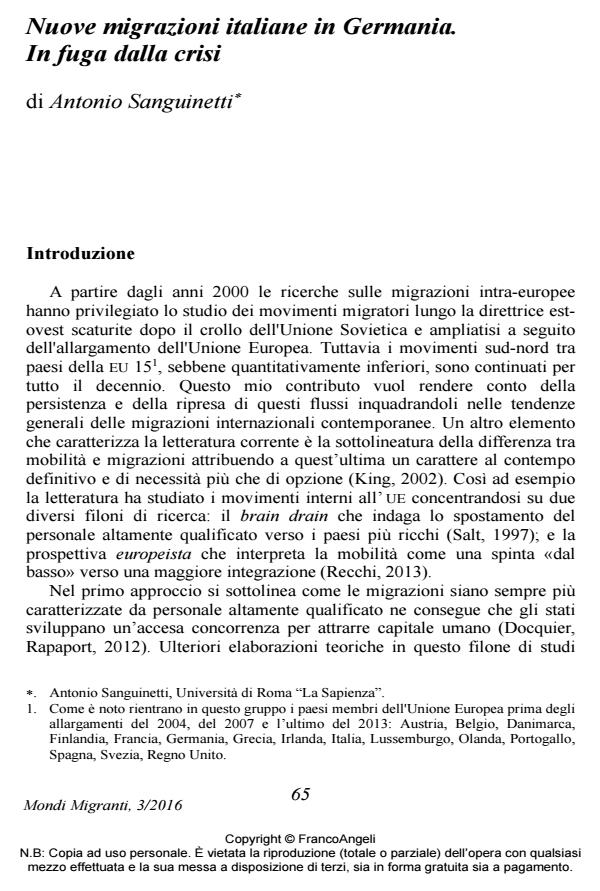New Italian migration to Germany. Escape from crisis
Journal title MONDI MIGRANTI
Author/s Antonio Sanguinetti
Publishing Year 2017 Issue 2016/3
Language Italian Pages 14 P. 65-78 File size 184 KB
DOI 10.3280/MM2016-003005
DOI is like a bar code for intellectual property: to have more infomation
click here
Below, you can see the article first page
If you want to buy this article in PDF format, you can do it, following the instructions to buy download credits

FrancoAngeli is member of Publishers International Linking Association, Inc (PILA), a not-for-profit association which run the CrossRef service enabling links to and from online scholarly content.
During the whole first decade of the new millennium the Italian population living in Germany has been slightly decreasing. Since 2010 it started to grow again. It’s not just a matter of quantity but of quality as well: whereas Berlin was the most likely destination till 2010, afterward the majority of Italians headed toward the other Länder of the former west Germany. These were the historic destinations of the Italian Gastarbeiter. The German statistics on the job market confirm this tendency. The data show a strong increase of the number of employed Italians, both in the «standard» job market - with regular full-time jobs, social security and health care - as well as in the minijob market. The article, based on Italian and German data, aims to investigate and depict the main features of the new Italian immigration in Germany.
Keywords: Crisis; Intra-Eu migration; escape; Italy; Germany
- Great Expectations? Young Southern Europeans Emigrating in Times of Crisis Iraklis Dimitriadis, Giovanna Fullin, Maricia Fischer-Souan, in MONDI MIGRANTI 3/2019 pp.127
DOI: 10.3280/MM2019-003007 - Young Italians in European countries: social and economic perspective Raffaele Ferrara, Gerardo Gallo, Armando Montanari, in Belgeo /2018
DOI: 10.4000/belgeo.29516 - La nuova emigrazione nel crocevia migratorio italiano Enrico Pugliese, in SOCIOLOGIA E RICERCA SOCIALE 123/2020 pp.138
DOI: 10.3280/SR2020-123009 - The new Italian emigration between necessity and choice: “Cordless workers” in Athens Grazia Moffa, in Academicus International Scientific Journal /2021 pp.91
DOI: 10.7336/academicus.2021.23.06 - Scivolando verso il basso. L'inserimento lavorativo dei nuovi migranti italiani e spagnoli in Germania durante la crisi economica Simone Castellani, in SOCIOLOGIA DEL LAVORO 149/2018 pp.77
DOI: 10.3280/SL2018-149006
Antonio Sanguinetti, Nuove migrazioni italiane in Germania. In fuga dalla crisi in "MONDI MIGRANTI" 3/2016, pp 65-78, DOI: 10.3280/MM2016-003005